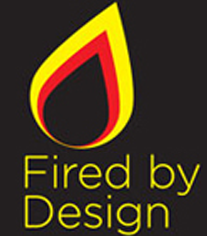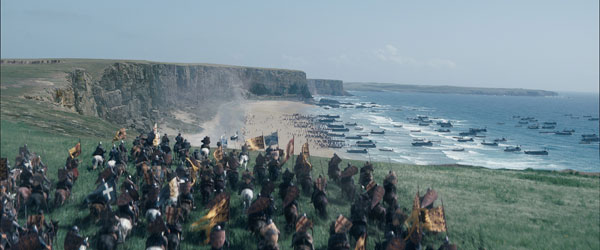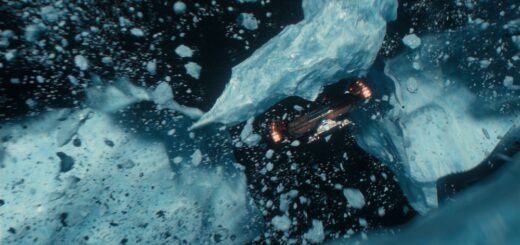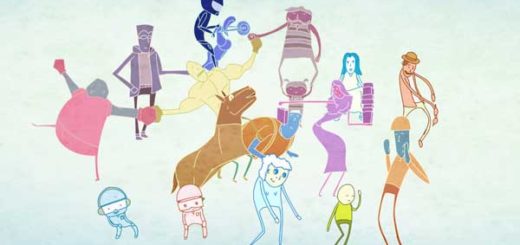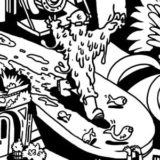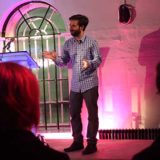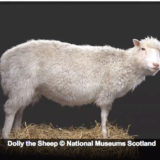One of MPC’s main challenges was to create the invading French Armada and the ensuing battle with the English army. A CG fleet of 200 ships and 6000 soldiers were added to the 8 practical boats and 500 extras used in principal photography. MPC used Alice, its proprietary crowd generation software to simulate the rowing and disembarkation of French soldiers and horses, with all water interactions being generated using Flowline software. The defending English archers and cavalry where also replicated with CG Alice generated clips and animated digital doubles. MPC relied predominately on its existing Motion Capture library for much of Robin Hood, but a special mocap shoot was organised to gather additional motion clips of rowing, disembarking troops and horses.
For the beach environment, MPC had to create cliffs that surround the location, and were added to 75 shots. The live action helicopter plate was shot on location at Freshwater West, Pembrokeshire in Wales and was captured using a Panavision Genesis camera.
Once approved in concept, the cliff geometry was modelled using Maya and interchangeable cliff textures were projected depending on the lighting conditions
“This shot was turned over to MPC early on in the schedule and became key development shot, to test the look our CG assets,” recalled Stammers. “It was used to conceptualise the digital environment work, which required the creation of cliffs that surrounded this location – a necessary story point to create a tactical advantage for the English archers. Also the shot was used to determine the layout and number of boats in the French Armada and the numbers of soldiers on the beach. It paved the way for over a 150 other shots that required views of the cliffs or the French Armada.
“For the design of the cliffs, MPC’s environment lead Vlad Holst created some Photoshop concepts for Ridley. Initially these were based on the white chalk cliffs of Dover, as this was the scripted location of the French invasion. The final design however, was based on the practical necessity to have a real cliff location to shoot non-VFX shots, which was in close proximity to the main beach location in Wales. These cliffs, whilst quite different from the concepts were a good geological match to the beach, and ultimately provided a better blend to the sand dunes behind the beach. Textures of the cliffs captured by the aerial unit were tiled, graded and projected onto simple Maya geometry that blended to a Lidar scan of the beach location. The cliff geometry went through a number of shape variations for Ridley’s comments with the approved version including a wide access path to the beach for the bulk of the cavalry and a narrow gorge from which Marion could join the battle later.
“Ridley wanted to feel that the end battle involved around 2000 soldiers on each side,” continued Stammers. “The French Armada was made up of 200 CG boats, and this shot featured about half the visible fleet and 1500 disembarked French soldiers. The practical photography provided a good guide for scale and lighting, with 4 landing craft, 4 rowboats, over a hundred extras on the beach and 25 cavalry in the foreground. Ultimately much of this was replaced with CG when the beach was widened in order to maintain continuity of the tide position throughout the sequence. Boat layout and animation was handled in two stages, divided by a period where matchmove artists would roto-animate the waves in the backplate. This allowed for detailed animation and interaction with the ocean surface to be achieved.”
MPC’s crowd simulation software ’Alice’ provided digital artists with the tools to handle the number of CG soldiers required. Alice utilised MPC’s motion capture library for most of the animations but with specific actions like rowing, disembarking soldiers and horses being realised through a specific mo-cap shoot.
“Digital effects elements such as wakes and splashes were created for the boats and CG soldiers in the water, using pre-cached Flowline simulations, which were automatically placed with each Alice crowd agent at render time,” said Stammers. “The small numbers of foreground cavalry were multiplied with the addition of full CG riders. Safety regulations prevented the helicopter’s camera from being close enough to the live action cavalry, so Ridley requested that MPC add the additional CG characters right into the foreground and under the camera. For this task, ‘Alice’ crowd agents, which are inherently suited to being smaller in frame, were promoted to having a high level of detail. Additional modelling, texturing, animation, cloth and fur simulations were required to provide the extra details and nuances to what became almost full frame CG renders. The effects team again provided interaction elements for the horses’ hooves, in the form of mud clumps, grass and dust, augmented further in the final composite with additional live action dust elements.”
MPC was also responsible for creating the arrows for various sequences on the film. Practical blunt arrows were used in production where ever possible, but most shots presented safety issues so digital arrows were animated instead. Arrows were added to over 200 shots, with 90% of these being handled by the compositing team using Shake and Nuke. MPC developed proprietary 2D and 3D arrow animation tools to assist with the volume of arrows required, which included automatically generating the correct trajectory and speed, and controls for oscillation on impact.
Bees and stings
The Film VFX division of Prime Focus in the UK also delivered 150 VFX shots for Robin Hood.
One of the main sequences upon which Prime Focus worked involved creating CG bees for scenes involving beekeeping Friar Tuck (portrayed by Mark Addy). Tuck uses his bees to attack enemy soldiers he has trapped in a building. The bees explode from their hives and swarm around soldiers who desperately try and swat them away.
Ridley Scott had very specific ideas for the scene, and the team worked closely with him and VFX producer Allen Maris to make sure the shots were up to their rigorous standards. Because the bees were swarming around, it was difficult to render them in layers, so everything was modelled in 3D and then tracked and match-moved using SynthEyes. Creating the entire environment in 3D made the rendering and compositing simpler and allowed the team to position everything correctly in the 3D space. This way, Scott’s vision of where the bees were placed could be realised.
The lighting and sheer number of bees also made the scene more challenging. “The general mood of these shots is quite dark but also features some stronger shafts of light within the room,” said Steve Street, joint MD/senior VFX supervisor, Prime Focus Film VFX. “The difficulty was finding a happy medium where the CG was lit realistically, but where it was light enough to see the bees. As the bees had to pass through the shafts of light, the extra lighting had to be very subtle. We also had to deal with several thousand bees, so motion blur was critical. We ended up having to add a lot of hand-animated bees into the foreground…to add detail where the simulation wasn’t good enough on its own.”
Prime Focus completed a number of other shots on the film, including designing more than 40 additional bee shots, creating CG arrows and swords for battle scenes in which people were stabbed or shot, as well as crafting matte paintings, green screens, fire and other FX additions.
See more stories about The Moving Picture Company on Fired By Design
